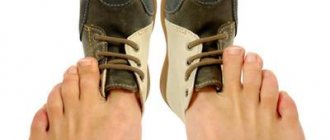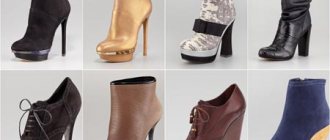Children
4 years ago
Add a comment
- Anastasia
2,552 views
There is no doubt that first shoes are important for babies who are starting to walk. But how to choose it correctly? There is a kind of “conflict of generations” taking place here. For example, grandmothers are sure that shoes without arch supports will cause irreparable harm to the child, and modern doctors, Komarovsky E.O. In particular, they claim that this detail in children's shoes for healthy feet is absolutely unnecessary. Whose advice should you listen to? Let's consider the nuances of choosing the first shoes for a child starting to walk.
Children's legs and flat feet
In the leg of a newborn baby there are 4 cartilages, which over time transform into bones.
Most children have healthy feet from birth, but parents need to remember that cartilage tissue can easily become deformed; their task is to contribute to the formation of a healthy child’s foot. Therefore, choosing the first shoes for a small person is very important. The most interesting thing is that doctors’ advice on choosing first shoes for a baby in Russia and abroad is strikingly different. Our old-school doctors recommend that all mothers buy “orthopedic” shoes, with a high, hard heel, and a mandatory insole with arch support. Considering the thriftiness of many mothers, children receive sandals as their first pair, albeit beautiful, but uncomfortable, at least a size larger than necessary.
Abroad, parents choose light, flexible, and the softest shoes for their children. But this causes bewilderment among our caring mothers - what about flat feet?
Surprisingly, any child with healthy feet under 2 years of age can be diagnosed with flat feet. But this is functional flatfoot, that is, it is temporary. The task of parents during this period, according to Dr. Komarovsky, is to provide the child with sufficient mobility, walking barefoot on uneven surfaces, sand, pebbles, and climbing the wall bars. Creating a reasonable and natural load on children’s feet contributes to the correct formation of their feet, and as a result, flat feet will disappear. The arch of the baby's foot is created by strengthening the muscles of the legs.
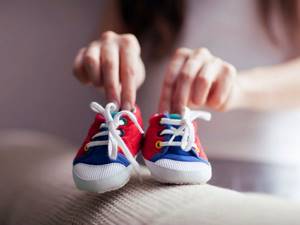
The first shoes for a child do not have to be orthopedic
Indeed, orthopedic shoes are made only to order for the child’s characteristics. A healthy child does not need it.
Attention! So-called “orthopedic” insoles with arch support can be dangerous for the baby’s feet if the shoes are chosen incorrectly or are oversized. Indeed, in this case, the position of the instep support shifts. It can put pressure on the baby’s fragile leg bones, causing him pain, and cause gait deformation.
Tips for parents - how to choose shoes for a child and save money?
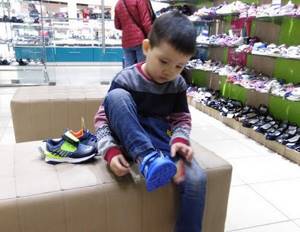
This question worries all caring parents, because the proper development of the child’s foot depends on the quality and comfort of the shoes, and this is very important.
Many mothers and fathers have heard that orthopedic shoes are preferable for children, but they don’t really know what kind of shoes they are and whether they should be worn only as prescribed by a doctor. And they are also tormented by doubts: is it possible for younger children to wear the older ones’ shoes?
- I have three children, it’s not profitable for me to take shoes that will tear after a while. Therefore, every season I have a headache about where to buy quality shoes,” says Ulan-Udenka Elena Andreeva. – The most important thing for me when purchasing is that I can buy it all in one place, and that it doesn’t put a strain on the family budget.
As the woman admits, sales help her to buy shoes at a good price and avoid overpaying for purchases. It is profitable to buy shoes for children during the off-season or at the very end of it.
“But the most important thing is that I try to shop in one place,” says Elena, a mother of many children. – With three children you can’t run around the city. And it is important to choose a store where the price matches the quality. It’s better to spend money on good shoes, it’s not without reason that they say “the miser pays twice.” By buying high-quality shoes, we already save money, since they will last a long time. Of all the stores, I liked O buvka the most.
There is a variety there, prices are normal for my budget, and the quality is excellent.
Many parents know that children's shoes should be selected especially carefully. And for good reason, because a developing child’s foot can be easily deformed if put in uncomfortable shoes, and this is fraught with many negative consequences in the future (flat feet, scoliosis).
To help Elena figure it out, we turned to specialist Irina Malkova, a medical orthopedist, with questions about how to choose shoes for a child.
— Is it possible to buy high-quality shoes for a child in a shoe store or should you buy them from a specialized one?
— Orthopedic shoes are divided into two categories: medical orthopedic and preventive orthopedic. The first category includes shoes that are prescribed only by a doctor for a certain pathology of the patient. These shoes are made to order at prosthetic factories or in special brand stores,” says orthopedist Irina Malkova. - And the second category - preventive orthopedic shoes - are shoes that it is advisable for all children to wear so that their feet are positioned correctly. Preventive shoes differ from the rest in that they have minimal orthopedic elements that are considered mandatory: a hard heel (so that the foot does not “ride” in different directions) and a flexible sole (it allows you to roll the foot when walking). As soon as a child begins to walk, he needs to purchase just such shoes so as not to damage his feet. These shoes can be purchased at any shoe store.
— Is it possible to wear shoes for older children?
- Under no circumstances should children wear shoes! Even if the older child only wore these shoes for two weeks! Even at the age of 1 year! After all, each child has his own gait and leg structure. For example, when walking, a heel usually wears out, and if it wears out from the inside, it means that the child’s feet tilt inward. This means that a child who will wear such shoes for someone else will have their feet also forced to tilt inward, that is, be in the wrong position. Therefore, it is better not to wear shoes out,” said Irina Malkova.
Indeed, choosing high-quality shoes is a guarantee that you can wear them for a long time.
— Is it possible to buy shoes for growth?
“Tight shoes are uncomfortable and harmful to your feet, but shoes that are a size or two too big are also very bad,” says the specialist. — The fact is that the sole rolls only in a certain position when the foot is in its place. It is clear that children grow quickly and parents always want to buy shoes as they grow, but it should be remembered that shoes can be a maximum of half a size (!) larger, and not a size or two.
If from the very first steps the child wears good preventative orthopedic shoes, his foot will develop correctly, which means that many problems can be avoided. For example, flat feet. A doctor can make such a diagnosis only after 6 years of age, when it is possible to visualize the arch of the child’s foot, but before 6 years of age this cannot be done, because he has a fatty pad in this place and the arch is not visible. But if up to 6 years of age the child wears the right shoes, the foot will develop harmoniously and there will be no flat feet, as well as other orthopedic problems.
As the orthopedist clarified, children's shoes need to be changed: at the age of 1-4 years, every 3 months; 4-6 years every 3-4 months; over 6-7 years old - every season! This is especially true for replaceable shoes (for example, sandals that a child wears in kindergarten or at home all day!). Children, even with healthy feet, should not wear flip-flops or Crocs! These shoes are for the pool only.
In the store " About buvka"
» a huge selection of high-quality Russian-made children's shoes - orthopedic and sports, home and for kindergarten.
Russian brands: Kotofey, Skorokhod, Lel, Totta, Talibu, Shagovita, Top-Top, Kapika, etc.
Promotion: 15% discount on winter, demi-season shoes, school and classic shoes! Promotion period: from May 1 to July 31.
Take care of your children's feet! After all, the foot is the foundation of our body! What a foundation, such a house!
Store addresses: KTK Galaxy, boutique 225, Baltakhinova, 15 and Lenina, 23 “Fabric store”
When does a child need shoes?
To answer this question, you first need to understand that people actually invented shoes for him:
- to protect feet from damage and injury;
- to keep warm from the cold.
Dr. Komarovsky believes that a healthy child will need shoes when it comes to warming and/or protecting his feet.
While the baby is very small and does not even try to take his first steps, you can put any shoes/booties on his feet, since they have more of a decorative effect (they complete the look, warm the feet).
But for the first walks on street asphalt, children's feet need protection.
The first shoes must:
- correspond to the anatomical features and size of the child’s legs;
- be comfortable for the child;
- provide comfortable conditions for the legs;
- do not interfere with the development and growth of the baby’s legs.
Advice. To choose the correct size of the first shoe for a small child, you should place his foot on thick paper, trace and cut out the template with an increase of 1 mm. When purchasing children's shoes, the template should be compared with the insole of children's shoes. The insole of the baby's very first shoe should be 5-8 mm longer than the template, and 1-2 mm wider.
How to choose shoes for the winter
We answer in order: So, firstly, Kuoma, Demar and felt boots are shoes designed strictly for dry, frosty weather. If it’s warm outside, it will be hot and your foot will sweat and become wet, and if the weather is too slushy, it will all get wet. Felt boots will get wet faster, Kuoma will get wet slower because it uses high-tech fabric (try to drop water on a felt boot, the drop will roll off). But even such fabric will get wet after climbing in wet snowdrifts for an hour. What if it’s slushy, but just a little bit? For example, in large cities, even at -10, there are puddles of reagents on the sidewalks. And what if you need to run through these puddles to the kindergarten? If the bottom of the felt boots is made with a shoe, then the child will dribble without any problems and will be able to feel like Ronaldo :) In Kuoma, you don’t even need to dribble: along the bottom there is a wide black stripe called cordoba: this is genuine leather covered with a thin layer of rubber. It protects against both moisture and liquid (but let’s admit, these observations were derived experimentally - the Finns did not test Kuoma’s reaction to our reagents). With Demar, thanks to the high shape of their lower plastic part, everything will also be fine. Almost always “wet feet” in Demar and Kuoma are not because the shoes are wet, but because it is too hot and the foot is sweaty. That's why my feet get cold. By the way, here’s some advice: if you and your child are going to a shopping center and plan to stay there for a long time, then take a shift. Within 1-2 hours of walking in Kuoma (and in general in any warm non-membrane shoes), the feet of almost all children sweat. If after shopping/cafe/entertainment/cinema you decide to breathe some air for an hour or so, your foot may freeze. As a last resort, do not wear tights, but put on a thin sock, and after the shopping center, change it to a replaceable “walking” sock made of wool + synthetics. But still, it is best to take a shift or not put your child in warm shoes for walking in heated rooms. Why are such shoes so popular? Due to the price-thermal properties ratio, these are almost the warmest shoes for the winter. High fur boots will be warmer, but they are more expensive and more capricious to reagents/slush. High-quality, truly working membrane shoes are noticeably more expensive, and just warm shoes are more suitable for children than membrane ones. In addition, some Demar models are designed for very plump feet, making them comfortable to put on for a small child. Are Kuoma shoes membrane? No, not membrane, Kuoma does not have that same microporous film applied between the outer and inner layers as is usually the case in membrane shoes. But Kuoma is a technological shoe: it consists of layers, and an intermediate layer of plastic material retains the heat generated by the foot. Therefore, in some ways the principle of operation is similar to a membrane: if the foot itself produces heat, then it seems that the shoes warm better. Therefore, you can fully experience the technology of Kuoma from size 23, when the child is walking with all his might.
Requirements for children's first shoes. Selection rules
Dr. Komarovsky voiced the following requirements that children's shoes must meet:
- flexible, extremely thin sole;
- natural, soft material that provides ventilation;
- small heel;
- tight, fixing the ankle joint, the heel must be present;
- soft, moisture-absorbing, easy-to-remove insole.
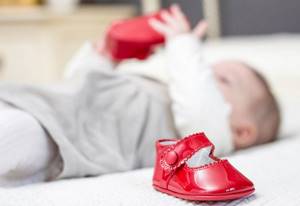
The baby's first shoes should be without instep support
The sole is the basis of children's shoes and should be elastic so as not to interfere with the natural movements of the foot. The sole of the baby's first shoes should be leather or very thin rubber, flexible, and always non-slip.
Children's feet sweat more than adults, so the use of natural materials from which shoes are made is especially important for them, providing a comfortable microclimate inside them. Soft leather or fabric are the best choices. It should not be forgotten that the baby’s socks should also be natural.
A small heel (5 mm) is necessary for a baby who is taking his first steps. It will prevent a child who loses his balance from falling backwards and hitting his head.
The heel of the first children's shoes should be moderately hard and moderately high. A tight heel provides reliable fixation of the ankle joint of the baby’s legs, but it should not turn the sandals into “lasts”. The baby should be able to move comfortably.
And finally, the insole in children's shoes under 2 years of age should be soft, cotton or leather, and always without an instep support.
So, the first shoes are very important in a baby’s life, and they should be chosen based not only on the beauty and functionality of the model. Natural material, flexible sole, no arch support and soft insole are the basic requirements for children's first shoes. The right shoes and an active lifestyle will help your baby develop beautiful, healthy feet, and he will never be diagnosed with “flat feet.”
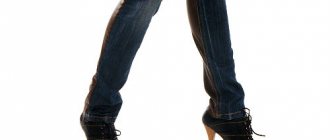
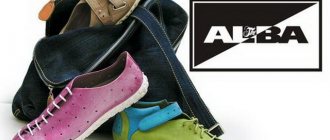
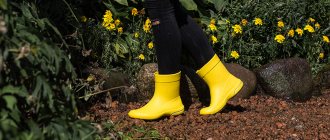
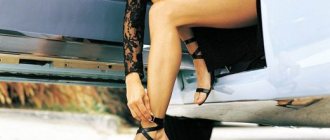

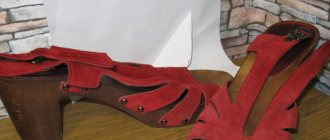


![[Photo review] “A Sassy Nation” bodysuit from Black Milk Clothing](https://superlady555.ru/wp-content/uploads/fotoobzor-bodi-a-sassy-nation-ot-black-milk-clothing-330x140.jpg)
